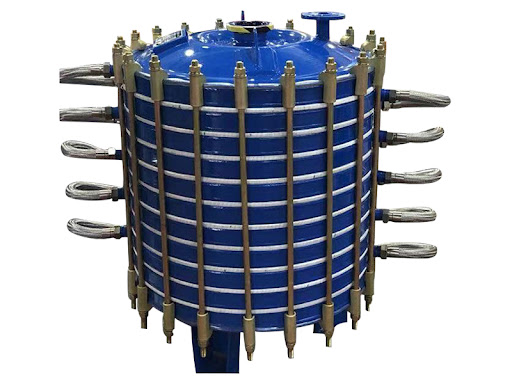Introduction
Glass Lined Heat Condenser is a specialized type of heat exchanger used for condensing vapors into liquids, particularly when handling highly corrosive, toxic, or ultra-pure substances. These condensers are commonly used in the pharmaceutical, chemical, and fine chemical industries where traditional metal surfaces may react with process vapors, leading to contamination or corrosion.
The glass lining (usually made from borosilicate glass or enamel) is fused to the internal metal surface at high temperatures, creating a chemically inert and corrosion-resistant barrier. This allows the condenser to handle aggressive media like hydrochloric acid, bromine, sulfuric acid vapors, and various solvents without compromising equipment integrity or product purity.
Working Principle of a Glass Lined Condenser
The basic principle is to cool down vapor phase substances so they change into a liquid state, without allowing the process fluid to come into direct contact with reactive or metallic surfaces.
Process Flow:
- Hot vapor enters the condenser (usually through the shell or tube side).
- A cooling medium (typically water, glycol, or brine) flows through the opposite side.
- Heat transfer takes place across the glass-lined wall.
- The vapor loses its latent heat, condenses into a liquid, and is collected.
- The glass lining ensures chemical resistance, non-contamination, and thermal reliability.
Design & Construction
- Shell Material: Carbon steel or stainless steel
- Tube or Surface Lining: Borosilicate glass/enamel fused lining
- Tube Options: Can be all-glass tubes, glass-lined tubes, or hybrid types
- Gaskets: PTFE, Viton, or other chemically resistant materials
- Orientation: Typically vertical or inclined for efficient condensation and drainage
Limitations of Glass Lined Heat Condensers
While offering numerous benefits, glass lined condensers come with certain limitations that must be accounted for during design and operation:
Not Suitable for Abrasive Media
The glass lining can be damaged by particulates or abrasive fluids, so it’s unsuitable for slurry condensation or unfiltered streams.
Lower Pressure Ratings
Compared to stainless steel or alloy condensers, glass lined units generally have lower maximum allowable working pressure (MAWP), limiting their use in high-pressure systems.
Handling Sensitivity
Glass lined equipment requires careful handling during shipping, installation, and operation to avoid cracks or mechanical damage.
Thermal Shock Limitations
Although resistant to moderate temperature swings, glass has a maximum delta-T rating beyond which cracking may occur. Proper start-up and shutdown procedures are essential.
Types of Glass Lined Heat Condensers
Various types of glass lined condensers are available to suit different industrial needs and scale:
Shell and Tube Glass Lined Condenser
- Common in large-scale chemical and pharmaceutical plants
- Offers robust performance and large surface area
- Suitable for both vertical and horizontal installation
All-Glass Coil Condenser
- Constructed entirely from borosilicate glass
- Ideal for laboratories, pilot setups, or small-batch production
- Compact, with excellent visual monitoring
Double Pipe Glass Lined Condenser
- Coaxial design for space-saving installations
- Excellent for compact systems with low flow rates
- Easy to maintain and scale up
Hybrid Glass-Graphite Condenser
- Combines glass lined shell with graphite tubes for enhanced thermal performance
- Balances chemical resistance with higher heat transfer efficiency
- Preferred in high-demand chemical production setups
Glass Lined Heat Condensers play a crucial role in industries that demand high chemical resistance, process purity, and long equipment life. By fusing a non-reactive glass layer to durable metal, these condensers ensure safe and efficient heat transfer even under the most aggressive vapor conditions.
They are indispensable in pharmaceuticals, chemicals, agrochemicals, and food industries, where ordinary metals would corrode or contaminate the product. While care must be taken to avoid mechanical damage or thermal shock, their performance, safety, and longevity make them an excellent investment for any sensitive or corrosive application.

